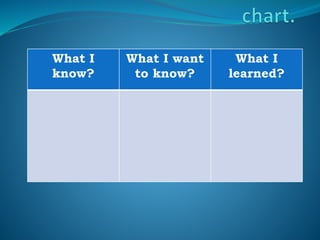
Introduction To Gas
- 1. What I know? What I want to know? What I learned?
- 2. Learning Competencies: 1. Describe gases. 2. Explain the postulates of the kinetic theory as applied to gases. 3. Relate how these postulates account for the properties of gases.
- 3. 11 elements of gases under normal atmospheric condition 1.Chlorine 2.Hydrogen 3.Oxygen 4.Nitrogen 5.Flourine 6. Helium 7.Argon 8. Neon 9.Krypton 10.Xenon 11.Radon Ozone- another form of oxygen (gas at room temperature)
- 4. Name of Gas/ Mixture of Gases Some Useful Facts Uses Air Air is the gas all around us. Its a mixture of several different gases, mainly nitrogen (78%), oxygen (21%), and other gases (1%) It supports balloons and airplanes Without air, we cannot breathe and fires won’t burn. Natural Gas Natural gas comes from the ground. It burns easily (flammable) Natural gas is used as a fuel for heating. Oxygen Oxygen is produced by plants (during photosynthesis). Without oxygen, we cannot breathe and fires won’t burn. Oxygen is used in hospitals to help us breathe. Oxygen is used in manufacturing metals as well as steel in welding.
- 5. Name of Gas/ Mixture of Gases Some Useful Facts Uses It is combined with hydrogen for the propulsion of space shuttles. Carbon Dioxide Carbon Dioxide is needed by plants when they make food (during photosynthesis). All living organisms breathe out carbon dioxide when they make energy (from food) Carbon dioxide is the gas in fizzy drinks It is also used in fire extinguishers. Nitrogen Nitrogen is the main gas in the air (about 78%) Nitrogen is use to make plant food (fertilizer) and is also used in explosives.
- 6. Name of Gas/ Mixture of Gases Some Useful Facts Uses Water Vapor Is formed when water evaporates. There is a lot of water vapor in the air we breathe. When water vapor in the air cools down it forms water vapor. Helium There is a small amount of helium in the air. Its very light gas and is used in the balloons to help them float. It helps balloons to float. Argon There is a small amount of argon in the air. Argon is the gas inside electric light bulbs.
- 7. Common Properties of Gases 1. they have indefinite shape. 2. two or more gases can be readily mixed evenly and completely because gases diffuse rapidly. 3. Compressible and expandable depending on the pressure applied to it. 4. less dense. Their density varies at the temperature and pressure changes. Density of air is 0.0012 g/cm3
- 8. Volume is the quantity of three-dimensional space occupied by a gas. Denoted by the symbol V S.I Unit is in Liters (L). Can also be expressed in mL, cm3 ,m3 ,dm3 1 litre= 1000 millilitres 1 millilitres= 1 cubic centimetre 1 cubic centimetre= 1000 cubic centimetre 1L=10dm3 =10 m3 =1000mL=1000cm3
- 9. Pressure Is the force exerted by the gas per unit area. depends on the kinetic energy of the molecules. Pressure and temperature is directly proportional. Pressure (P)= force or Pressure (P)= (mass) (acceleration) area area The S.I. Unit for pressure is (Pa)
- 10. 1 Pa = 1 N 1 m² 1 Pa= 1 kg.m/s² 1 m² 1 Pa= 1kg.m/s²
- 11. Other units of pressure atmosphere (atm) millilitre of mercury (mmHg) Torr Bar Kilopascal (kPa) Pounds per square inch (psi) 1 atm=760 mm of Hg=760 torr=1.01325 barr=101.325 kPa=101. 325 x 103N m²
- 12. Intruments use to measure Pressure Barometer Manometer closed tube manometer Open tube manometer
- 13. Temperature Is the measure of average kinetic energy of the particles of gas. Gas expands when temperature is increased. Gas contracts when temperature is decreased. °F , °C, K Used by the help of thermometer. Absolute zero= -273. 15 °C
- 14. To convert Celsius to Kelvin: K= °C + 273.15 Celsius Scale Kelvin Scale Absolute zero -273.15 0 Freezing point of water 0° 273.15 Boiling point of water 100° 373.15
- 15. Amount or Number of Moles The mass of the gas is related to the number of moles of the gas. Kg or g Number of moles (n) = mass of the gas molar mass of the gas n= m M
- 16. Kinetic Molecular Theory of Gases Gas , like any other states of matter, consist of very tiny particles, each of which has mass. Gases are most likely empty space because of a wide distance between these tiny particles. Thus, making gases compressible and have low density. The density of gases varies with changes in temperature and pressure. Gas particles move rapidly in straight lines, travel constantly, and in random directions. Gases diffuse very rapidly that allows two or more gases to mix readily when combined.
- 17. Because of the wide spaces between gas particles, the forces of attraction (Van der Waals Force) between them are negligible. Gas particles collide with each other or with the walls of its container but do not lose their kinetic energy; instead, it is only transferred to the lower-energy particle and will continue to move. In short, energy is conserved in elastic collisions of gas particles. All gases have the same average kinetic energy at a given temperature of gas. The average kinetic energy of gas particle is directly proportional to the absolute temperature of the gas. This means that gas particles might have higher kinetic energy at a higher temperature and vice versa.
- 18. Summary Gases are fluids with very low densities, are highly compressible, and expand/contract to completely fill whatever closed container they are put in. The Kinetic Molecular Theory of Gases provides a model to explain behavioral properties of gases.
- 19. Assignment What are the different gas laws? Write their formulas. Reference: 324-337 Science book
- 20. Prepared by : Ms. Ella B. Llamas
